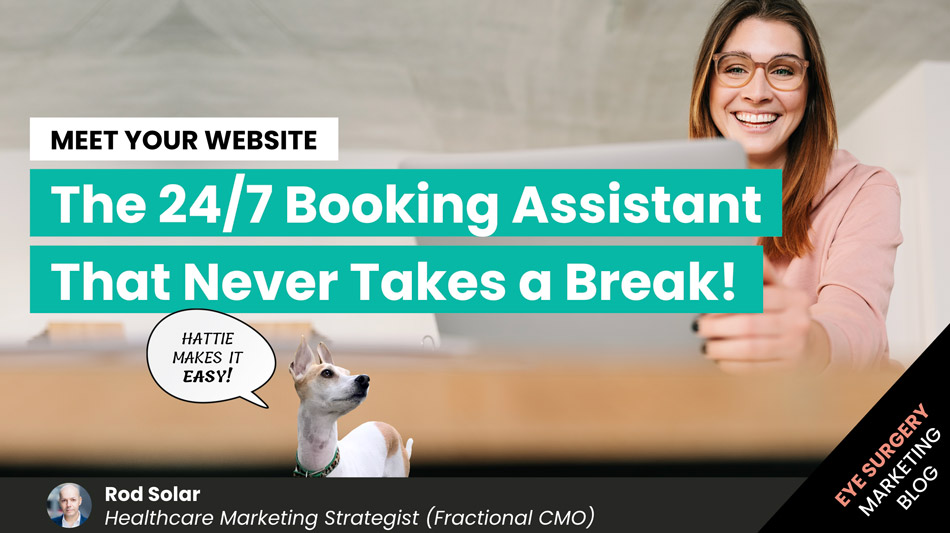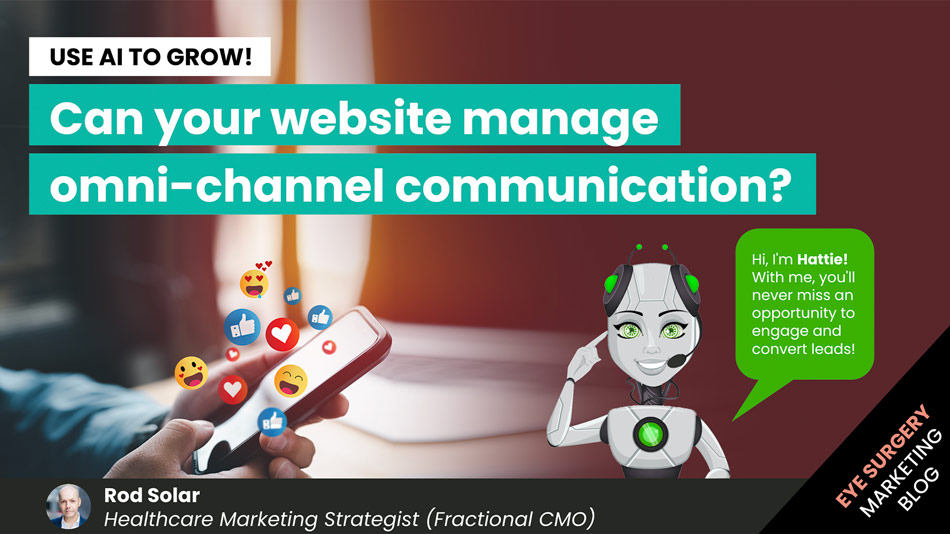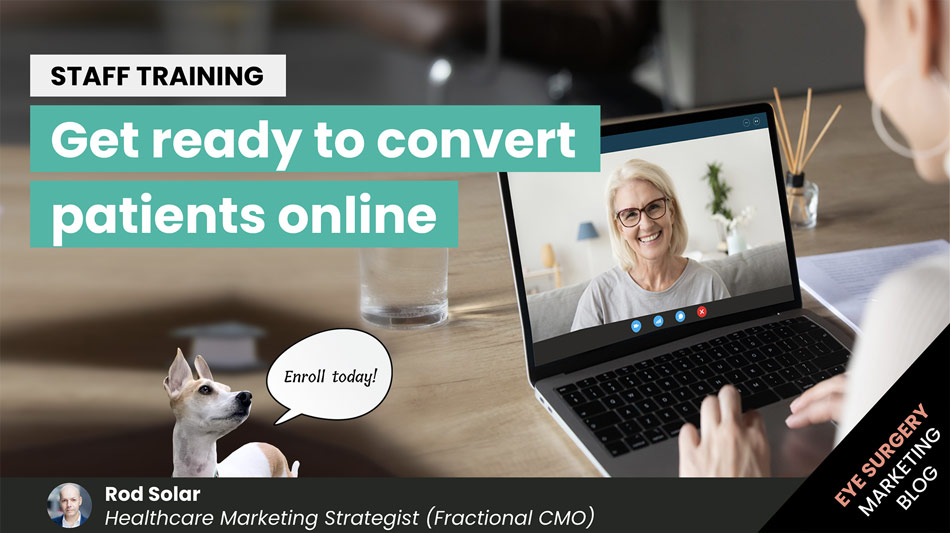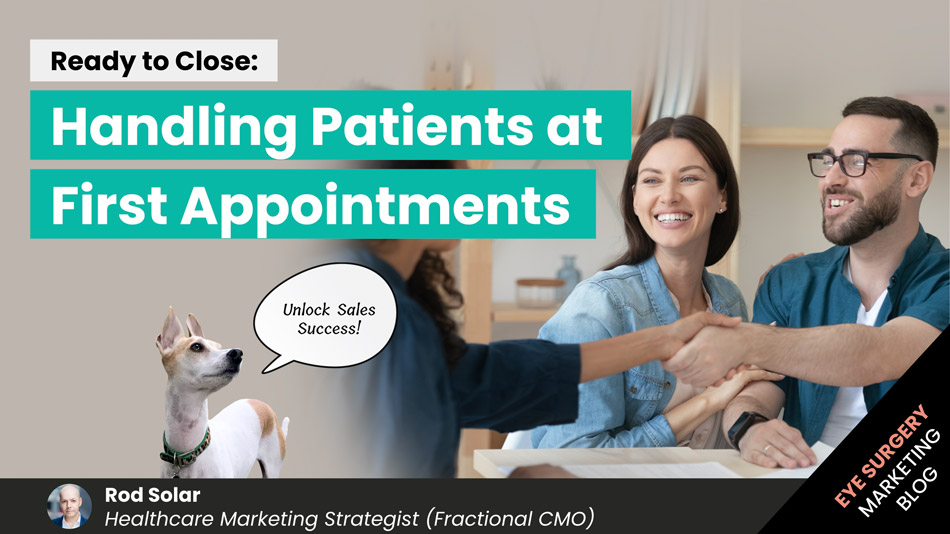Converting More Callers – Mini-Class
Rod Solar:
Hi, I’m Rod Solar of Livesey Solar, and we’re on a mission to help you build the practice that you love. Now, how do you engage in the telephone in order to double your bookings? It’s a question that we’re commonly asked: “How can we just improve some of our phone service? How can we get more patients to book in appointments?”
But if I could tell you that you could in fact double your bookings just by simply utilising the phone more appropriately than you do right now, I’m sure that’s probably something you’d be very interested in. How we do it is this:
Hire the right team
First of all, we hire the right people. Those are people who truly believe that what they’re doing for you on the phone is instrumentally valuable to your practice. They really, really have to believe that what you do is a good thing, that what your patients are going to get is a life-transforming thing.
They have to do everything in their power to engage on that phone properly in order to book that patient in. Only after they identify what they need, what their motivations are, and ask them questions in order to make a relationship with them.
The question here is: “How do I build trust? How do I do so within 15 minutes, 12 minutes, 10 minutes of a telephone call, where often the patients are calling and just simply asking about price?”
The key thing here is to take control of the call. Hiring the right people allow[s] you to do that. Because those people then have to be trained. Training is instrumental in getting people prepared to do this job properly. This is not a job that you can simply allow to be done off the side of a desk. This isn’t a job where somebody is doing something else and then is interrupted by a phone call.
It’s a job that requires dedication, and it requires a certain knowledge about how you do what you do. It’s not only knowledge about your product, or their service, or the medical terms that people are going to ask about.
But rather, it’s the knowledge of how to take somebody who, perhaps, is a little bit afraid of being sold, a little bit afraid of what they might be looking at in terms of pricing, afraid of what a procedure might feel like, afraid of going to the doctor for anything at all, and taking that prospective patient and guiding them through a process that enables them to generate as much excitement and trust the individual, who’s answering the phone, to take their leadership so that they can take the next logical step, which is to book an appointment.
Now let’s get into the phone call proper. How do you actually handle a telephone call in order to generate that booking?
Now, the very first thing that you have to do is…
Number one: be completely prepared to convert the telephone caller into a booking. That requires a certain mindset. What I like to invite people to do is actually even stand up so that they have the energy to engage the caller in such a way that it really makes them feel valued, and it makes them feel listened to. I find that when you’re standing up as well, your energy, your personal demeanour changes. So I often encourage people to stand to answer the phone, or at least when the phone rings, to stand, pick it up, and engage on the phone while they’re standing. The energy is completely different.
Perfect a warm welcome
The very first thing you have to do is obviously welcome the caller in greeting them. So it goes as simple as: “Good morning,” or, “Good afternoon (My clinic name), Rod speaking. How can I help?”
So it’s a nice four-part introduction in order to invite the patient to know that they’re calling the right place. Now the patient is going to potentially ask any question. Typically, that question involves, “How much does your service cost?” Or, “Do you offer this or that service?”
Now, whatever question they ask, what’s super important here is for the person on the receiving end of the phone (your employee), to take control of the call right from that point forward. Whatever question is asked, invite them to say something like this: “I appreciate it. That’s a really good question. I can answer that and many other questions for you. But if that’s okay, I’d like to get a few details from you first so that I know who I’m speaking with, and so I can understand what it is that you need most. Then I can provide you the answers that are most suitable for you.”
With that, you’ve taken leadership, and that’s central. Because it provides the caller with a sense that, “Okay, I’ve called somebody who actually knows what they’re doing. They’re in control. They have a plan.” As soon as that happens, that vacuum of leadership is sorted out. Because then the caller doesn’t feel like they have to take leadership and drive the phone call to its logical conclusion. It prevents them from feeling the need to ask all these questions.
Usually what happens is that the caller feels like: “Well, I have to ask all these questions. I’ve got to prepare in advance.” Then they’ll fire questions off at the person handling the phone. I don’t want that to happen. Instead, what I’d like to happen is for the call operator to take control of that phone call and then have them ask the questions.
Gather the minimum data set
The next thing you have to do is you now have to get the minimum data set. The minimum data set is typically, what’s their name? What’s their phone number, in case you get disconnected? And how do they hear about you? Those are the three points of data that you need in order to initiate the phone call. Most of the time, if you ask with confidence, they will provide that information. So you take all of that down. You ensure that you write those notes in the file, because you’re going to use that information throughout the call, and potentially after the call after you book them. Then you simply start off by saying: “Well, thanks very much for calling. My name is Rod. I’m one of the patient liaisons here. Would it be okay if I ask you a few questions in order to understand your needs better?”
Next, ask your question clusters
With that, you’ve effectively structured the agenda for the call. What is the caller going to say? 99 times out of 100, they’re going to say, “Yeah, please.” Who doesn’t want to get their needs known in order for you to answer their questions better? That’s what we’re after. Then, once the caller gives their permission to have questions asked of them, you begin asking your questions. I propose a series of 10 questions. But really, what they are, are question clusters. You have to think about it in that respect, that if I say: “Ask this question,” I’m also thinking about follow-up questions. I’ll give you an example.
Question #1
The very first question you want to ask is: “Tell me a little bit about what issues you’re calling about.” So you’re asking about their ‘before’ state. The before state is essentially what the patient has, whether it’s a condition or a problem they want to fix, how they feel about that problem, what daily impacts they experience, and how others see them, and how they see themselves in the overall story that is going to get them moving through the journey that you’re trying to help them along.
But really, what I want the telephone operator to do is just simply ask, “Tell me about the issues that are concerning you.”
Question #2
Secondly, once the patient answers, then ask: “Well, how do you feel about that?” That’s the second part. So first, you have the ‘what’, then the ‘how’.
Question #3
The last part is, after the patient answers that: “Tell me about the impacts that’s having on your life.” That’s the ‘why’. Why is this a problem? When you structure the questions in that way, you effectively are peeling the onion. What you’re doing really here is pulling down the levels.
Channel your patient’s emotions
First of all, we’ve got a problem. Second is, how we feel about the problem. Third is, what impact does that have on their life? What we’re trying to do here, the meta-message behind all of this, is we’re trying to get the patient emotional.
Why? Because emotion is what gets people to make decisions. Emotion is what gets people to say, “Yes, I want to fix this. This is a problem. I need to address it.” Facts don’t do that so well. Facts are used in order to justify emotional decisions.
The first thing we do is we ask them about their past. What’s happened before?
Get them to recall their past motivating incident
Secondly, we ask them to tell us about a specific incident that occurred in their past. I call it the past motivating incident. In that, what we’re doing is we’re getting the patient to relate a story, something that happened in their past that was significant enough to get them to move past the point where they are now, compelled to make a change. Of course, it’s related to their problem. If we’re talking about, say, an eye problem, and they wear glasses that they don’t like, they feel unattractive in their glasses, and it’s having a major impact on some of their social opportunities.
“Well, can you tell me about a time when that caused you distress? Okay. Can you tell me about a time that caused you distress?” That’s the second question. Ideally, they will answer with, “Well, yeah, there was this one time where I couldn’t get my contact lenses in because I had an eye infection – so I wore my glasses. I went out for a date and I really didn’t feel comfortable at all because I hate the way I look in my glasses.”
Establish you’re trustworthy
Then you’ve got to ask: “Well, how did that go? How did that turn out?” Now, you’re probably thinking right now, these are really personal questions. But in reality, people are very, very keen to share what’s very important to them with somebody that they trust. If they trust you enough, they will share this with you. You need to be able to provide that kind of leadership and that kind of confidence that enables people to trust you.
People will do business with people that they trust. This is a trust building exercise, so you do have to go there. You do have to ask these questions, and you do have to get them to answer. The key to this is getting the answers. If they’re telling you anyway, then you don’t have to ask the question.
NOTE: The best way to answer that nagging question about practice growth or marketing or patient volume in the back of your mind is to book a free 15-minute compatibility call. Get some options and go away with a clear idea of what’s possible.
Where do they want to go? What’s their future-motivating event?
The third question about the future. Where would you like to go? How do you envision the solution to these issues? In what state would you like to be? That really addresses the ‘after’ state. We really have to think about, okay, we take patients to the past where they experience pain, and then we move them psychologically to the future where they experience gain. We have to have both ends of the equation. Because if we don’t, then we’re missing out on the major hope that we can provide them that will ideally lead them to see you as the guide that leads them to that hope.
Then fourthly, we ask them about their future motivating event. Is there a time in the future when you’re hoping to experience the benefits of having this solution? For example, if we were talking about the laser eye surgery example again, the future could be a life without glasses. Well, wouldn’t that be wonderful? That’s what they want. That’s why they’re really calling. Not because you offer laser eye surgery, but because they want a life without glasses.
Now, you might ask them: “Well, is there something in the future that you’re looking forward to once you’ve achieved that state?”
They might say to you: “Well, actually, now that you mention it, I actually am going to attend my sister’s wedding, which is going to happen in March.” Great. Well, that gives us a date in time by which time the solution has to be in place.
Create a sense of urgency for your patient
Now, what are we doing here? What we’re doing is we’re creating urgency for the patient. What they’re now thinking is that, “I don’t just want to have laser eye surgery. I want to have laser eye surgery because this is a big problem. I want to have laser eye surgery because I hope to transform into somebody better than I am today. Most importantly, I hope to have it before March, so that I can have that wedding experience without glasses, and I can appear great in those pictures.”
That’s the whole emotional constellation that we’re trying to build for a patient, and that’s critical. Just so you know, it doesn’t matter whether it’s laser eye surgery, or dental surgery, or plastic surgery, or chiropractic, or physio. It really doesn’t matter what you’re offering. Everybody has a before state and an after state. Everybody has a place that they want to leave, and a place where they want to go. That’s why they’re calling you. That’s what your job is, to guide them through point A to point B.
Justify their feelings with logical questions
Then we ask certain questions in order to justify their feelings. That’s important, because people can’t run off fumes of feelings alone. We might be able to get them excited. But as soon as they go and talk to their partners, or to their parents, or to other people who they trust – those people with good intentions. They’re going to ask them: “Are you sure this is a good idea? Have you done your research? Have you done your homework?” Now we have to build the scaffolding underneath this emotional heart. How we do that is we effectively ask them logical questions.
These logical questions are questions like: “Have you been to any other place before in order to see whether or not this is an option for you? What other things have you tried in order to solve this problem that perhaps did not work (which is why you’re calling me today?) Is there anyone else involved in helping you make this decision in order to move forward with this journey? At what point in time would you like to have everything in place, and free and clear of all the aftercare appointments so that you can move on with the rest of your life? When would you finally like to take the next step?”
We might also even ask: “Do you have any concerns that you’d like to ask the practitioner when you actually come and visit us at the appointment?”
What you’ve done here now, over the span of maybe five to seven minutes, is take the patient on a journey that goes into their emotional states. We get to their before, we get to their after, and we build a nice spine of support underneath their emotional heart.
Offer your patient two dates
Finally, you confirm all the information that you’ve asked for. So you say something along the lines of this. “Well, I think I really understand the situation that you’re in. I’ve heard many patients with similar concerns”. What they’ve found is that after coming in for a consultation, we can assess whether they are suitable for the procedures that we offer, and make a proper recommendation as to where to take the next step. Most people at that stage decide to move forward, assuming they’re suitable, and assuming everything looks good to them. “Does that sound like something you’d be interested in?”
Now, the patient at this stage has to say yes. Because you’ve effectively answered their question. If I can get you from before to after within the deadline, well, more at this stage, what can they say? Once you ask that question, they should, at that point say: “Yeah, sounds like a good plan.”
Then what you need to do is then you need to offer them two dates. Typically, a choice is better than a: “Do you want to come in for an appointment?” That’s implied now. So you offer them two dates. You offer them two times. You say, “Well, great. I’ve got that appointment for you. Do you have any questions about how to get to us? Anything that you need to prepare?” They may or may not have questions.
Now you proceed into the process of telling them everything that they need to know in order to prepare for the appointment, let them know that you’re going to be confirming that appointment, and send out everything that you promised exactly when you promised to send it.
That’s how you can go through the process of getting the patient emotionally engaged, generating a substantive, logical foundation under that emotional decision, and inviting them to an appointment.
Why should you bother improving your conversion rates?
Now, it’s super important to understand why we’re doing all of this work. Why we’re taking the time to create a process, why we’re rehearsing, why we’re trying to improve conversion rates at all. The main reason is this. If you have 20 patients contact your clinic, and only five go through, well, that’s great. Five people come to an appointment, and you’ve got some business going. Let’s say that five of those patients, all of them say yes. Wouldn’t that be lovely? But let’s say they all do, okay? That’s five patients out of 20 calls. Now, if you improve your conversion rate from five to 10, and everybody goes through after that, then you’ve effectively doubled your business. That’s super important, because it didn’t actually require you to spend any more money on marketing. It didn’t require you to work any harder per patient.
Effectively, what you’ve done is you’ve leveraged the telephone to its maximum potential by putting all the right ingredients in place to make it really work for you.
About the author
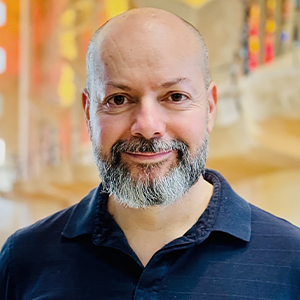
Rod Solar
Founder & Scalable Business Advisor / fCMO
Rod Solar is a co-founder of LiveseySolar and a Scalable Business Advisor for its customers. Rod mentors and coaches eye surgery business CEOs/Founders and their leadership teams to triple their sales, double their profit, and achieve their “ideal exit”.
Related Posts
Meet our Co-Founders
We’re passionate about helping leaders of high-quality, growth-minded practice owners double their practice revenue

Rod Solar
Founder & Scalable Business Advisor
For over 20 years, I’ve helped ophthalmology entrepreneurs scale their private practices. I specialise in doubling revenue within three years by offering a proven framework, hands-on experience, and a team of experts who implement what works. We take the guesswork out of growth and scale, so you can focus on delivering exceptional patient care while maximising the value of your business.
LiveseySolar completely transformed the way we were approaching this… We’ve gone from having just the dream of having a practice to having a practice up and running with people making inquiries and booking for procedures… It’s extremely pleasing. We feel lucky we connected with LiveseySolar.
— Dr Matthew Russell, MBChB, FRANZCO, specialist ophthalmic surgeon and founder of VSON and OKKO

Laura Livesey
Founder & CEO
I’m the co-founder & CEO of LiveseySolar. I’ve developed powerful eye surgery marketing systems that increase patient volumes and profits for doctors, clinics, and hospitals, since 1997.
Rod and Laura know as much about marketing surgery to patients as I know about performing it. They are an expert in the field of laser eye surgery marketing. They know this industry inside out. I believe that they could help many companies in a variety of areas including marketing materials, sales training and marketing support for doctors.
— Prof. Dan Reinstein, MD MA FRSC DABO, founder of the London Vision Clinic, UK






